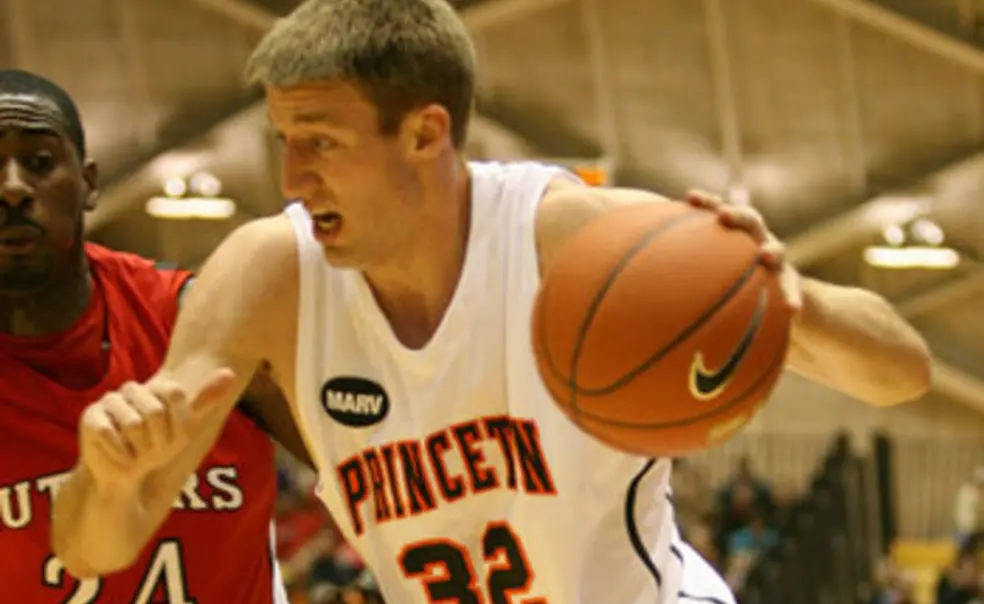Ten things to know about Princeton men's basketball (part two)
Through 10 games this season, PAW contributor Kevin Whitaker ’13 has compiled a list of 10 things to know about the 7-3 Princeton men’s basketball team. This post presents the second half of the list. For part one, click here.
Reserve forward Mack Darrow '13 is part of Princeton's eight-man rotation. (© Beverly Schaefer)
6. Biggest weakness: lack of depth.
Ian Hummer ’13, Kareem Maddox ’11, Douglas Davis ’12, and Dan Mavraides ’11 have all played more than 31 minutes per game. Four others average double digits, while nobody else has played more than 26 total minutes all season. The message is simple: Coach Sydney Johnson ’97 has eight players he can trust in important situations. Most of Princeton’s opponents regularly play 10 guys or more, and few ride their top four like Princeton. (Interestingly, one of the few other teams with four guys averaging 30-plus minutes is Harvard, the other Ivy League favorite. The Crimson has an excuse, however – 2009-10 Ivy League Rookie of the Year Kyle Casey has seen very limited time due to injury, thinning out Harvard’s rotation.)
This lack of depth has some consequences. First, Princeton’s margin of error this year is very slim. If one of its rotation players gets injured, especially one of its top four, the Tigers will have trouble replacing him. Also, it might not be a coincidence that Princeton starts strong in games but has trouble holding leads – the best Tigers spend more time on the court than their counterparts, which might be a disadvantage late in games against opponents with fresh legs. (On the other hand, Princeton has played very well after the 40th minute this season, winning all three overtime games.) It seems unlikely that Johnson will change anything dramatically while riding a five-game winning streak, but if the second-half collapses continue into January, he may have to consider pulling back the pace or finding another player he can trust.
7. Biggest strength: Shooting.
Quite simply, the Tigers can make shots. Maddox and Hummer are effective from inside the arc, while Davis, Mavraides, and Patrick Saunders ’12 are efficient from outside – each has made more than 40 percent of his three-point attempts. Princeton ranks 33rd in the nation in effective field-goal percentage (which adjusts for the fact that three-pointers are more valuable).
More broadly, the Tigers are now winning with offense, a major change from last year. Princeton allowed just 53.3 points per game in 2009-10, by far the nation’s best. Though this was partly due to their slow pace (see No. 1 from yesterday’s post), the Tigers still ranked third in points per possession. This season, they are out of the top 200 in the latter category, but they have improved from 204th to 76th in offensive efficiency.
8. This is not your father’s Princeton offense.
Beyond the faster pace, there are some stylistic differences between this offense and the ones of yesteryear. Elements of the traditional Princeton offense remain – constant motion, pinpoint passing, and backdoor cuts – but Johnson has given his players more leeway to create shots for themselves. In the decade before he took over – with Bill Carmody, John Thompson ’88, and Joe Scott ’87 at the helm – 67 percent of Princeton’s field goals were assisted. Under Johnson, that number is down to 56 percent. Last year, the Tigers often set up plays for Davis, a skilled ball-handler and the team's leading scorer for the past two years (most memorably in the final minutes against then-No. 22 Cornell); this season, many of those one-on-one touches are going to forwards Hummer and Maddox.
9. You won’t blow the Tigers out. (Unless you’re the defending national champions.)
Princeton’s trip to Cameron Indoor Stadium, predictably, ended with an easy victory for the No. 1 Duke Blue Devils; the Tigers closed to six points at the half, but the hosts pulled away and led by as many as 40. When not playing the nation’s best team, however, Princeton has never trailed by double digits. Princeton had a chance to win the other games it eventually lost (at James Madison and vs. Presbyterian) until the final buzzer.
10. Get ready for some more excitement.
Fans at Jadwin Gymnasium have seen plenty of late-game drama over the last two years, and all signs point to more in 2011. Three of Princeton’s 10 games have gone to overtime, and three others were decided by three points or less; even a 66-55 victory at Bucknell was a two-point game inside the two-minute mark. This is nothing new for the Tigers: Last season, nine of their 31 games were decided by one possession or went into overtime, including both games against league rivals Cornell and Harvard.













No responses yet